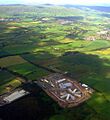Glasgow Bridge, Kirkintilloch facts for kids
Glasgow Bridge is a special place in Scotland. It's where a road bridge crosses the Forth and Clyde Canal. But it's also much more! This spot was once home to a small Roman fortlet. It was part of the famous Antonine Wall, right between the bigger Roman forts at Kirkintilloch and Cadder.
Contents
The Road Bridge at Glasgow Bridge
The road bridge you see today is an important crossing. It carries the A803 road over the Forth and Clyde Canal. This bridge helps connect the areas of Cadder and Kirkintilloch.
Originally, this was a swing bridge. This means it could swing open to let boats pass through the canal. Over the years, the bridge has been repaired many times. When the canal was closed for a while, the water was sent through a special tunnel called a culvert. The bridge was put back into use in 1990 when the canal reopened for boats.
Just west of the bridge, there's a basin. This is a calm area where boats can be launched into the canal. The bridge is about halfway between the cities of Glasgow and Kilsyth. It has been marked on maps for a very long time, showing its importance.
The Stables and Canal Horses
Long ago, horses were very important for the canal. They would walk along the towpath, pulling boats along the water. Their hard work helped move goods and people across Scotland.
Today, the work of these canal horses is remembered. At The Helix, further east along the canal, you can see two huge horse sculptures. They are called The Kelpies and are a tribute to the horses that worked on the canals.
Near Glasgow Bridge, there was once a building called 'The Stables'. This building was used to house the horses that worked on the canal. Later, it was turned into a bar and restaurant. You might even see a fun road sign nearby that mentions "Craft daft (on a raft)".
The Roman Fortlet at Glasgow Bridge
Long, long ago, the Romans built a small fortlet right here. This fortlet was part of the Antonine Wall. The Antonine Wall was a huge barrier built by the Romans across Scotland. It was made of turf and ditches, meant to protect their land.
Today, you can't see any Roman remains on the ground. But if you look at old photos taken from airplanes, you might spot where the fortlet once stood. These photos, taken since 1955, show a square area about 20 meters wide. This area was likely protected by a turf wall and a ditch. Experts think there might have been a bridge over the ditch to enter the fortlet.
This Roman fortlet was located just east of the modern road bridge over the Forth and Clyde Canal. It was an important lookout point. Kirkintilloch was to the east, and an area called Low Moss was to the south. There was also a temporary Roman camp nearby at Easter Cadder. This camp was halfway between the Glasgow Bridge fortlet and the main Roman fort at Kirkintilloch.
If you were walking west along the Antonine Wall, its path would change direction after the Glasgow Bridge fortlet. This shows how the Romans carefully planned their defenses.
Images for kids






